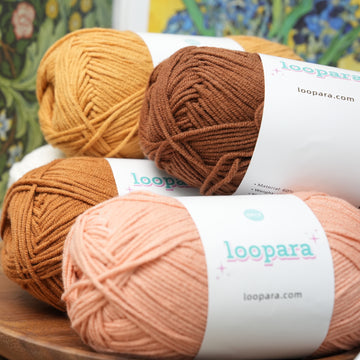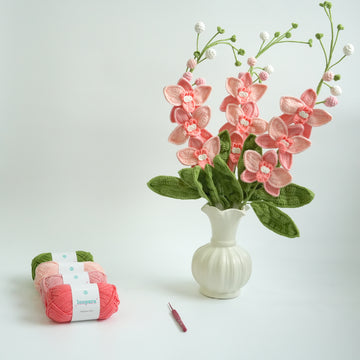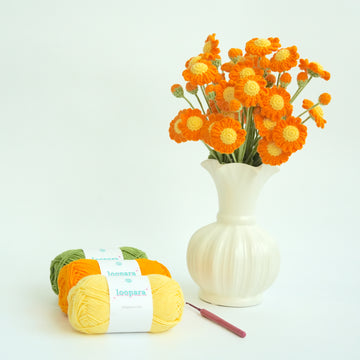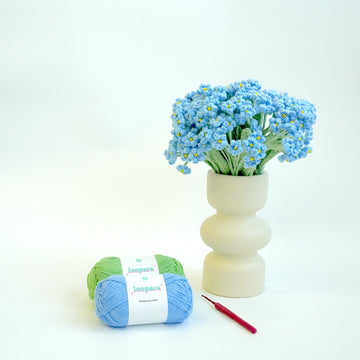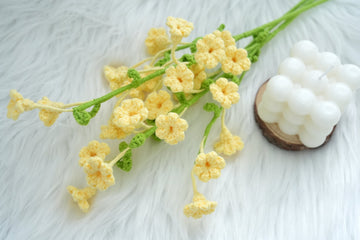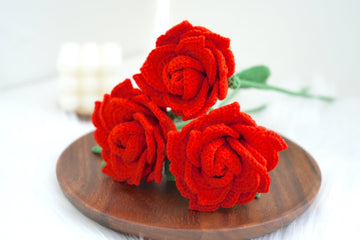Are you ready to start your new hobby and are searching for some hints and tips? Then our guide to how to crochet for beginners is for you!
We’re going to take you step by step through the equipment you need, how to hold the hook, and how to start making stitches. And we’ll explain how to fasten off your yarn when you’ve finished too.
Equipment for crochet

To start crocheting, all you really need is a hook and some yarn. There are also a few other pieces of equipment that will make your life easier. We’d recommend:
- Scissors – to cut your yarn.
- Yarn needle – you’ll use this to weave in the ends of your yarn when you’ve finished.
- Tape measure – to measure the fabric you make. When you’re a bit more experienced and following crochet patterns, you’ll also need a tape measure to check the gauge of the item you’re making.
- Stitch markers – you can use these to mark the beginnings and ends of rows. That can help you keep things nice and even when you’re just starting out.
Also Read: What Do You Need to Crochet? (12 Items)
Choosing your yarn
There’s a huge range of different yarns out there. They’re made of different fibers, come in different colors and textures, and have different thicknesses.
When you’re just starting out, it’s a good idea to choose a yarn:
- with a texture that’s smooth, but not too smooth. Cotton or a smooth wool is a good choice, because you’ll be able to see the stitches easily. If the texture is too fuzzy, that will be more difficult. And if it’s too smooth – like silk yarn, for example – you may find it’s prone to slipping off the needle.
- in a paler color. That will help you see the stitches more easily, so they’re easier to count.
- with a medium weight. “Weight” in crochet terms means thickness. Yarns come in eight different weight categories, with 0 being the thinnest and 7 the thickest. A medium weight yarn will be easy to handle and will work up into fabric fairly quickly. Look for yarns labeled 4 – also known as worsted weight, Afghan or Aran.
Also Read: 4 Types of Yarn for Crochet (Pros & Cons)
Choosing your hook

Hooks come in different shapes, sizes and materials. When you’re beginning to crochet, we’d recommend choosing a hook:
- the size that’s recommended on the label of the yarn you’re using. If you’ve gone with our recommendation of a medium weight yarn, that will probably be a hook sized I/9 (or 5.5 millimeters in the metric system). If that feels too big for your hand, try going down a size to H/8.
- made of aluminum. Aluminum hooks are lightweight and smooth, helping the yarn to slide along the hook. If you find your yarn is slipping off the hook too easily, you could try a plastic, or even a wooden hook instead.
Crochet hooks also come in two different styles – inline and tapered. The terms refer to the different shapes of the hook, and there are different opinions on which is easier for beginners to use.
Some people find tapered hooks easier, because the yarn slides down them more readily. Others say inline hooks make it easier to keep an even tension.
There’s no right and wrong answer here – it will all depend on your crocheting style. It can be a good idea to invest in both types and try them out. Then stick with whatever feels more comfortable for you.
Also Read: Crochet Hook Size Chart & Guide for Beginners
How to hold your hook
Your crochet hook goes in your dominant hand – i.e. the one you write with. You’ll use your other hand to hold your yarn.
There are two main grips you can use to hold the hook. These are known as the pencil grip, and the knife grip. And just as with the style of hook, which grip you use is really just a matter of personal preference.
With the pencil grip, you hold the hook as if it were a pencil you were writing with. With the knife grip, you hold it as if it’s a knife you’re using to slice vegetables.
Whichever grip you choose, you’ll hold the hook around the middle point. With many crochet hooks, you’ll see a small indentation there. That’s the finger hold, and it’s designed to make it more comfortable to hold the hook.
The hook should be facing slightly towards you as you start to crochet. That will help you see what you’re doing as you hook the yarn.
Also Read: How to Hold Crochet Hook & Yarn (Step by Step)
Making a slip knot
You can check the beginning of below video (We didn't make a video specifically for the slip knot because it's a super easy step.)
To start crocheting, you need to attach your yarn to the hook. You do that with a slip knot.
Make a loop with the yarn and slide it over the top of the hook. Now bring the free end under the hook, then slip it through the loop. Pull it tight, and you’re ready to go.
If you find that awkward, you can make the knot on your finger and then pass it over the hook instead. To do that, just hold out your index finger on the hand that will hold the yarn. If you’re right-handed, that will be your left hand, and vice versa.
Then wrap the yarn twice around the top of your index finger, so the short end (i.e. the bit that’s not attached to the yarn ball) is at the front. You should have two loops of yarn around your finger. The second loop should be behind the first one, further away from your fingertip.
Now use the thumb and middle finger of the same hand to hold both ends of the yarn tight. Your thumb and middle finger will be pinching the yarn between them.
Now the yarn is secure, you can use your other hand to move the back yarn loop over the front one. You’ve now made your knot! Slide the back loop gently off your finger and onto the needle. Pull on the long end of the yarn to tighten it.
You can know take the other loop off your finger, and you’re ready to go.
How to hold your yarn
Now that your yarn is attached to your hook, you need to know what to do with the rest of the yarn!
There are lots of different ways of holding the yarn. Some people even use crochet rings – rings that sit on your finger and through which the yarn can be threaded.
There’s no right or wrong way to do this. The important thing to know is that how tightly you hold your yarn will determine how tight your stitches are. This is known as your “tension”. The tighter you hold the yarn, the higher the tension, and the smaller and tighter the stitches.
One easy way to hold the yarn is to simply wrap it around your hand. To do this, start by holding your crochet hook with the yarn attached with the slip knot. You want to hold it in your dominant hand, as if you’re about to start crocheting.
Now take the working end of the yarn – the bit attached to the yarn ball. With the palm of your non-dominant hand facing forward, pass the yarn between your index and middle finger, from front to back. Wrap the yarn around your index finger and bring it to the front.
Next, pass the yarn across your hand and around your pinkie. Pull the yarn across the back of your hand, and pass it to the front again between your middle and index fingers. You now have a wrap of yarn at your chosen tension.
Getting the right tension is something that comes with practice and experimentation – so don’t worry if it takes time. If your stitches are too tight, loosen up that yarn wrap. If they’re too slack, pull it a bit tighter.
Making a chain
Now everything is in place for you to start crocheting!
The chain is the foundation from which most pieces of crochet start. To make one, hold your needle and yarn in your preferred grip. Remember, your hook is in your dominant hand – the one your write with – and your working yarn is in your other hand.
Use the middle finger of your dominant hand to hold the slip knot in place on your hook. Now use your other hand to bring the yarn over the hook, from the back to the front. Grab the yarn with the hook, and pull it through the slip knot.
That’s it – you’ve made your first chain stitch! Keep going for as long as you like. It’s a good idea to count the stitches as you go, as you’ll need to do this when following a pattern.
Note that when you’re counting chain stitches, the slip knot doesn’t count, and nor does the chain at the end. What you’re counting is the little “v” shapes that form each stitch.
You’ll end up with a line of stitches that looks like a braid.
Chain stitches are a great way to practice your tension. You want a chain that’s loose enough to see through, and which your hook fits into easily.
If your tension is too tight, you’ll find the stitches too tight to slip your hook into. Relax your grip on the yarn and your tension should loosen. Alternatively, you could swap your hook for a slightly bigger size.
Also Read: How to Chain Stitch (ch) - Beginner Tutorial
Single crochet
Now that you have a crochet chain, you can use this as the foundation for a single crochet stitch. (Note that this is US terminology – in the UK, the same stitch is called a double crochet.)
Start by inserting your hook into the second stitch down from the top of the chain (i.e. the bit nearest the hook). Remember, the loop on the hook already doesn’t count. You want the hook to go under the top loop of that second stitch. That will leave you with two loops on your hook.
Now bring the working yarn from the back of the hook to the front. Pull it up, so that it sits under the hook. This is known as a “yarn over”.
Now gently pull up the top loop on the hook so that it goes over the head of the hook. At this point, you’ll still have two loops on your hook.
Now bring the working yarn from the back of the hook to the front again. In other words, repeat the “yarn over”. This time, pull the head of the hook through both the loops on the hook.
Congratulations! You’ve completed your first single crochet stitch. Use a stitch marker to slip under the top two loops of your stitch, so you’ll know where it is as you continue to crochet.
Also Read: How to Single Crochet (sc) - Step by Step Tutorial
Other crochet stitches
Now you’ve got chain stitches and single crochet under your belt, you’re ready to move on to more stitches. Other basic options include double crochet, treble crochet, half-double crochet and slip stitch.
Check out crochet how-to guides, blogs and YouTube videos for help. Making granny squares is a great way to practise your new repertoire. And your squares can be used for coasters or sewn together to make items like scarves or blankets.
Also Read: 44 Different Types Of Crochet Stitches
Finishing off
When you’ve finished crocheting your item, it’s time to fasten off the yarn so your stitches don’t unravel.
To do this, cut the yarn so that you’re left with a “tail” about 6 inches long. Now take your hook and drawn the yarn tail through the loop on the hook.
You can now slip the yarn from the hook, and pull on the yarn tail. That will tighten the knot and keep your stitches in place.
Finally, thread the yarn tail through your yarn needle. You can now use it to weave the yarn back through the fabric, so it doesn’t show.
Advanced Resources
Once you have mastered the basics, you can try our free Patterns.
- Free Crochet Flower Patterns
- Crochet Leaf Pattern Free
- Crochet Rose Pattern Free
- Crochet Granny Square Free Patterns
- Crochet Bag Pattern Free
How to crochet for beginners: a quickfire summary
The first step is to assemble your equipment. All you need is a hook and yarn that go together, and a pair of scissors. A medium weight yarn (look for “4”, worsted, Aran or Afghan on the label) and an aluminum I/9 hook are a good pairing for beginners.
Start by getting comfortable with holding your hook and yarn. Practice making chain stitches, then move onto single crochet. Before you know it, you’ll be moving on to new stitches and patterns.
Good luck on your crocheting journey!


